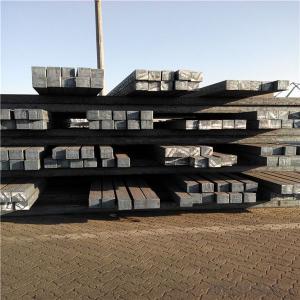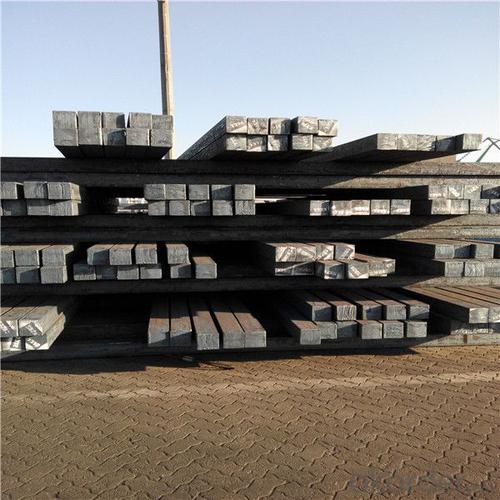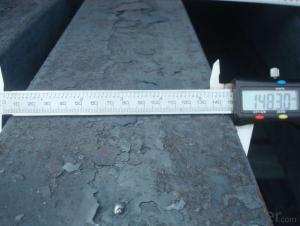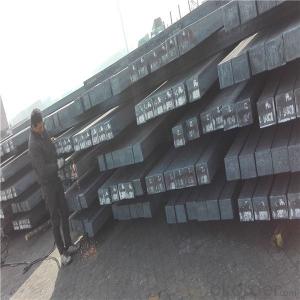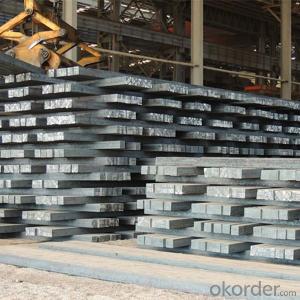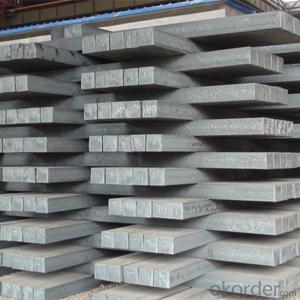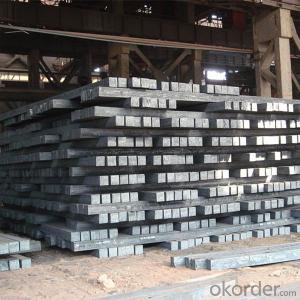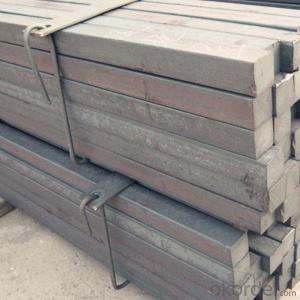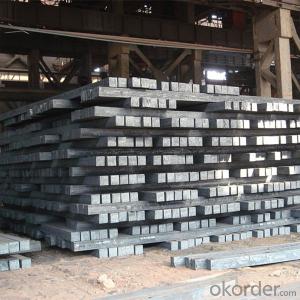STEEL BILLET 120MM/130MM/150MM made in China
- Loading Port:
- Tianjin
- Payment Terms:
- TT OR LC
- Min Order Qty:
- 1000 m.t.
- Supply Capability:
- 17532 m.t./month
OKorder Service Pledge
OKorder Financial Service
You Might Also Like
Specification
Steel billets have distinct characteristics as compared with already furnished steel bars and products.
Billets have a specific grain structure, which enables the metal to be processed more intricately. Steel
billets are also known for their malleability and ductility, especially when exposed to varying temperatures
during shaping and molding.
The billet is mainly divided into two kinds from the shape:
Slab: cross section width and height of the ratio of the larger, mainly used for rolling plate.
Gade:
Standard | C(%) | Mn(%) | S(%) | P(%) | Si(%) |
Q195 | ≤0.12 | ≤0.50 | ≤0.040 | ≤0.035 | ≤0.30 |
Q235 | ≤0.20 | ≤1.40 | ≤0.045 | ≤0.045 | ≤0.35 |
Q275 | ≤0.22 | ≤1.50 | ≤0.045 | ≤0.045 | ≤0.35 |
20MnSi | 0.17-0.25 | 1.2-1.6 | ≤ 0.050 | ≤ 0.050 | 0.40-0.80 |
3SP | 0.14-0.22 | 0.40-0.85 | ≤ 0.050 | ≤ 0.040 | 0.05-0.15 |
5SP | 0.28-0.37 | 0.50-1.00 | ≤ 0.050 | ≤ 0.040 | 0.15-0.30 |
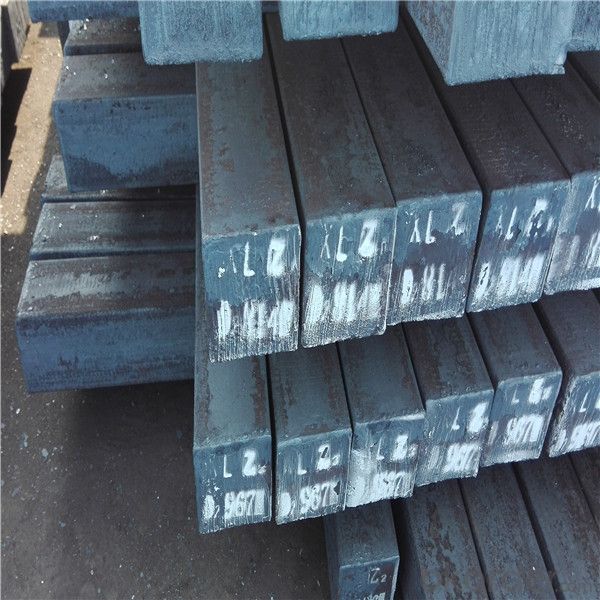
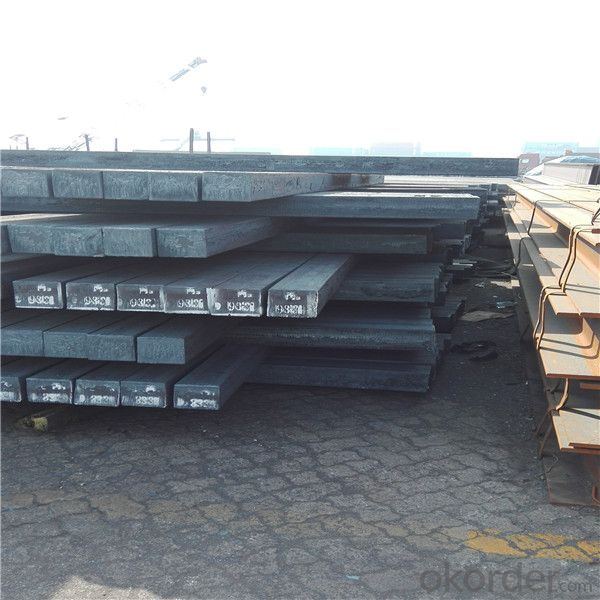

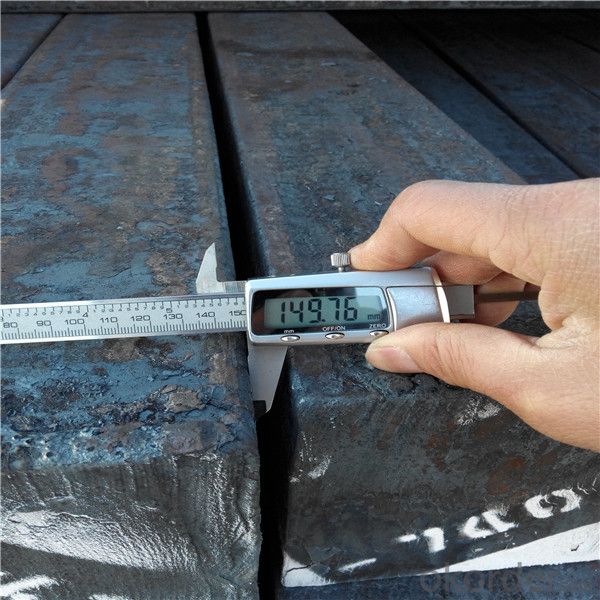
Other Specifications
Size :100mm to 165mm
Length:6~12meters
Squar Tolerance: ±4
Length Tolerance: +100mm
Romboidity/Difference Diagonals: no more than 0.7%
Camber: no more than 1.5%(%)
Twist: no more than 3 degrees per 1 meter length
Our Advantage
* Professional Personnel of Steel Trading
* Strong Steel Industry Background
* Conveniently Geographic Location
Our Commitment
* Sincere, Practical, Efficient and Developing
* High Quality Steel Production
* Competitive Price and Timely Delivery
Packing :
Within 30 days
1.Standard export package
2.In bundles with steel strips
3.As the requirements of the customers
FAQ:
Q: How to get quotation?
A: When we receive your detailed enquiry, we will set the best price based on standard,
steel grade, outer diameter, wall thickness, quantity, country.
And we will send quotation to your mailbox.
Q:How to guarantee the quality of the products?
A:We have established the international advanced quality management system,every link from raw material
to final product we have strict quality test;We resolutely put an end to unqualified products flowing into the market.
At the same time, we will provide necessary follow-up service assurance.
Q:How long can we receive the product after purchase?
A :In the purchase of product within three working days, We will arrange the factory delivery as soon as possible.
The pecific time of receiving is related to the state and position of customers.
- Q: How are steel billets used in the manufacturing of gears?
- Steel billets are used in the manufacturing of gears as the raw material for forging or machining processes. They are typically heated and shaped into the desired gear shape, either through hot forging or by cutting and grinding. The steel billets provide the strength and durability required for gears to withstand the heavy loads and high stresses they experience during operation.
- Q: Are steel billets used in the manufacturing of oil and gas pipelines?
- Oil and gas pipelines are commonly manufactured using steel billets. These billets are semi-finished products that are created through continuous casting, a process that solidifies molten steel into a rectangular form. They are utilized as the initial material for various steel products, specifically pipes for the oil and gas sector. The manufacturing process for oil and gas pipelines involves multiple steps, one of which is the production of seamless or welded steel pipes. Steel billets are heated and then rolled into tubes or pipes through a procedure known as pipe making. In the case of seamless pipes, the heated billet is pierced to create a hollow shell, which is subsequently elongated and shaped into a pipe. On the other hand, welded pipes are formed by rolling and welding a flat steel plate to construct a tube. The utilization of steel billets in pipeline manufacturing is favored due to steel's outstanding mechanical properties, which include strength, durability, and resistance to corrosion. These attributes make steel an ideal material for pipelines that must endure high-pressure environments and harsh conditions. Moreover, steel billets can be tailored in terms of size, shape, and composition to satisfy the specific requirements of each pipeline project. To summarize, steel billets play a critical role in the production of oil and gas pipelines. They serve as the raw material that undergoes transformation into seamless or welded pipes, enabling the transportation of oil and gas over long distances. The use of steel guarantees the dependability and integrity of these pipelines, establishing them as indispensable components of the oil and gas industry.
- Q: How has the demand for steel billets changed over time?
- Various factors have impacted the demand for steel billets, resulting in fluctuations over time. Historically, there has been a consistent increase in demand due to global industrialization and urbanization. As construction and infrastructure projects expanded, the need for steel billets as raw material also grew. However, economic cycles have affected the demand for steel billets. During periods of economic downturns, such as the 2008 global financial crisis, demand decreased as construction and manufacturing activities slowed. This led to an oversupply of steel billets, causing prices to drop and steel mills to reduce their demand. Recent years have seen the demand for steel billets influenced by global trends and geopolitical factors. The focus on sustainable development and environmental concerns has led to a rising demand for green construction materials, including recycled steel. To meet this demand, steel manufacturers have adjusted their production processes. Geopolitical factors, such as trade disputes and tariffs, have also impacted the demand for steel billets. The imposition of tariffs on steel imports by certain countries has reduced demand for imported billets while increasing demand for domestically produced ones. The COVID-19 pandemic had a significant impact on the demand for steel billets. Lockdowns, travel restrictions, and disrupted supply chains caused a decline in construction and manufacturing, resulting in reduced demand. However, as economies recover and governments implement stimulus measures for infrastructure projects, the demand for steel billets is expected to gradually recover. In conclusion, the demand for steel billets has fluctuated over time due to economic cycles, global sustainability trends, geopolitical factors, and the COVID-19 pandemic. Long-term growth in demand remains closely tied to construction and infrastructure development, necessitating adaptability from steel manufacturers.
- Q: How are steel billets used in the manufacturing of bars and rods?
- Bars and rods are manufactured using steel billets, which are an essential part of the process. These billets have a cylindrical shape and act as the starting point for producing different types of bars and rods. To begin, steel billets are commonly created through continuous casting. This method involves pouring molten steel into a mold, which then solidifies and forms a billet. To enhance their workability and reduce the risk of cracking during subsequent processes, the billets are usually heated to a specific temperature. After the preparation of the billets, they are sent to rolling mills where they undergo intense pressure and high temperatures. This process, known as hot rolling, gradually shapes the billet into the desired form by passing it through a series of rollers. Depending on the specific requirements of the bar or rod being produced, the rolling mills can be equipped with different types of rolls, such as flat rolls or grooved rolls. During hot rolling, the billet is elongated and reduced in cross-sectional area, resulting in a longer and thinner product. This transformation enables the production of bars and rods with consistent dimensions and improved mechanical properties. Moreover, the hot rolling process refines the grain structure of the steel, thereby enhancing its strength and toughness. Following hot rolling, the bars or rods may undergo additional processes to achieve specific characteristics. These processes may include quenching and tempering, which optimize the mechanical properties of the final product, such as hardness and ductility. In conclusion, steel billets are crucial in the manufacturing of bars and rods. They are transformed through the hot rolling process to achieve the desired shape, dimensions, and mechanical properties. The versatility of steel billets allows for the production of a wide range of bars and rods used in various industries, including construction, automotive, and manufacturing.
- Q: How do steel billets contribute to the manufacturing of renewable energy equipment?
- Steel billets are an essential component in the manufacturing of renewable energy equipment, such as wind turbines and solar panels. These billets are used to create sturdy and durable structures, including tower bases for wind turbines and frames for solar panels. Additionally, steel billets are crucial in the production of transmission and distribution infrastructure required for renewable energy systems. Their strength and versatility make them an indispensable material in the renewable energy industry, enabling the efficient and reliable generation of green energy.
- Q: What are the main factors affecting the formability of stainless steel billets?
- The main factors affecting the formability of stainless steel billets include the composition of the steel, its microstructure, temperature, strain rate, and lubrication during the forming process. Additionally, the presence of impurities, such as sulfur and phosphorus, can also impact formability.
- Q: How are steel billets used in the manufacturing of construction machinery?
- Steel billets are used in the manufacturing of construction machinery as raw material for forging, casting, and machining processes. They are formed into various components such as gears, shafts, frames, and structural parts, providing the required strength and durability for heavy-duty applications in the construction industry.
- Q: Can steel billets be used for making hand tools?
- Hand tools can be made using steel billets. Steel billets are semi-finished steel products that are commonly used for further processing and shaping into different forms. Steel billets can be used to manufacture various hand tools such as wrenches, pliers, hammers, screwdrivers, and many others. Steel is a popular choice for manufacturing hand tools because of its strength, durability, and resistance to wear and tear. Steel billets can be forged, machined, or heat-treated to achieve the desired shape, size, and hardness required for hand tools. The versatility of steel allows it to be easily molded into different tool designs, providing the necessary strength and functionality. Moreover, steel hand tools offer several advantages over tools made from other materials. The high tensile strength of steel ensures that the tools can withstand significant force and pressure without breaking or deforming. Additionally, steel tools are resistant to corrosion and rust, making them suitable for both indoor and outdoor use, even in harsh environments. In conclusion, steel billets are indeed suitable for manufacturing hand tools. The strength, durability, and versatility of steel make it an excellent material for producing a wide range of hand tools that can endure heavy usage and provide long-lasting performance.
- Q: How are steel billets used in the manufacturing of bars?
- Steel billets are an essential component in the manufacturing of bars. They serve as the starting point for the production process. Billets are typically a semi-finished product that is obtained through the continuous casting of molten steel into a solid form. These billets are then further processed to create different types of bars. Once the steel billets are obtained, they are heated to high temperatures to make them more malleable. This heating process, known as hot rolling, helps to reduce the size and shape of the billets to the desired dimensions. The billets are then fed through a series of rolling mills, which apply pressure to the material, gradually shaping it into bars. During the rolling process, the billets undergo a significant reduction in thickness and length, resulting in a longer and narrower shape. The rolling mills have a set of grooves that impart the desired shape and dimensions to the billets. As the steel passes through these grooves, it undergoes plastic deformation, causing the material to elongate and take on the shape of the bars being produced. Once the desired shape and dimensions are achieved, the bars are cut to the required lengths and cooled. This cooling process, known as quenching, helps to improve the mechanical properties of the bars, making them stronger and more durable. Furthermore, the bars may undergo additional processes such as straightening, surface treatment, or heat treatment to further enhance their properties. The bars produced from steel billets find applications in various industries, including construction, automotive, manufacturing, and infrastructure. They are used in the construction of buildings, bridges, and roads as structural components. In the automotive industry, bars are used for making axles, shafts, and various other components. Additionally, bars are utilized in the manufacturing of machinery, equipment, and tools. In conclusion, steel billets play a crucial role in the manufacturing of bars. They are transformed through the hot rolling process into the desired shape and dimensions, resulting in the production of high-quality bars that are widely used across multiple industries.
- Q: How are steel billets used in the manufacturing of electrical equipment?
- Steel billets are often used as the raw material in the manufacturing of electrical equipment. They are typically melted and formed into specific shapes, such as coils or laminations, to create various components of electrical machinery. The high strength and durability of steel make it suitable for withstanding the demands of electrical equipment, ensuring reliable operation and long-term performance.
Send your message to us
STEEL BILLET 120MM/130MM/150MM made in China
- Loading Port:
- Tianjin
- Payment Terms:
- TT OR LC
- Min Order Qty:
- 1000 m.t.
- Supply Capability:
- 17532 m.t./month
OKorder Service Pledge
OKorder Financial Service
Similar products
Hot products
Hot Searches
Related keywords
